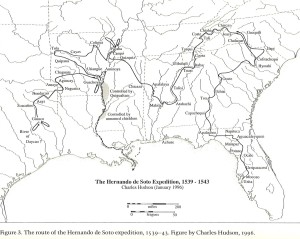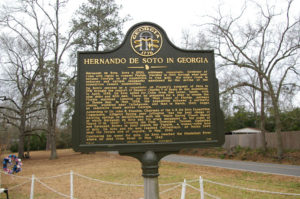This week’s #MarkerMonday examines Hernando de Soto and his travels throughout North America.
Historians have long debated the exact route de Soto and his men took on their journey throughout North America. Of the four surviving documents that detail their expedition, none provide consistent descriptions of locations or distances. The Final Report of the United States De Soto Expedition, written by Smithsonian anthropologist John R. Swanton was once the most referenced work on de Soto’s travels. This account remained largely unchallenged until the late 1970s when Charles M. Hudson, former professor at the University of Georgia, along with two graduate students began researching de Soto’s route. In 1984, they produced “The Hernando de Soto Expedition: From Apalachee to Chiaha” in Southeastern Archeology and constructed a new version of de Soto’s path across southern North America.

Map of Hernando de Soto's journey through La Florida according to historian Charles Hudson. Image: From Galloway, Patricia, ed. The Hernando de Soto Expedition: History, Historiography, and "Discovery" in the Southeast. Lincoln, NE: University of Nebraska Press, 1997.
The debate of de Soto’s route continues to present day. In 2006, Dennis Blanton, anthropologist at James Madison University, and his crew discovered glass and chevron beads in Telfair County, Georgia, approximately 90 miles southeast of where Hudson believed de Soto and his men journeyed. This find resulted in the largest collection of 16th-century Spanish artifacts found outside of Florida. The discovery of these beads and other artifacts, such as iron tools and a silver pendant, complicate Hudson’s research and suggests that de Soto and his men traveled an alternate path. Based on these findings, Blanton suggests that the glass beads’ site is the former location of the Ichisi village visited by the de Soto expedition in spring 1540. While it is impossible to know for certain the exact path de Soto traveled, many agree with Blanton’s theory, illustrating how technological advances and new archeological discoveries allow us to expand and reconsider historical research.
Explore the links below to learn more about de Soto’s journey and researching historical markers.
Georgia History Today Fall/Winter 2014
New Georgia Encyclopedia: https://goo.gl/uDeVSP
Georgia Stories: https://goo.gl/AZd6FF
The Archeological Conservancy: https://goo.gl/GlkqT9
Atlanta Journal Constitution: https://goo.gl/SRgmbK
North Carolina Digital History: https://goo.gl/3wQ7l1
Georgia History Festival: http://georgiahistoryfestival.org/
Further Reading:
- Clayton, Lawrence A., Vernon James Knight, Jr., and Edward C. Moore, eds. The De Soto Chronicles: The Expedition of Hernando De Soto To North America In 1539-1543. Tuscaloosa, AL: The University of Alabama Press, 1993.
- Galloway, Patricia, ed. The Hernando de Soto Expedition: History, Historiography, and “Discovery” in the Southeast. Lincoln, NE: University of Nebraska Press, 1997.
- Hudson, Charles and Carmen Chaves Tesser, eds. The Forgotten Centuries: Indians and Europeans in the American South, 1521-1704.Athens, GA: The University of Georgia Press, 1994.
- Hudson, Charles, et. al. “Coosa: A Chiefdom in the Sixteenth-Century Southeastern United States.” American Antiquity50, no. 4 (October 1985): 723-737.
- Hudson, Joyce Rockwood. Looking for De Soto: A Search Through the South for the Spaniard’s Trail.Athens, GA: The University of Georgia Press, 1993.
- Nystrom, Elsa A. “Hernando de Soto in Georgia.” In The New Georgia Encyclopedia. Georgia Humanities Council and the University of Georgia, 2005. http://www.georgiaencyclopedia.org/articles/history-archaeology/hernando-de-soto-georgia.html.
- Swanton, John R. Final Report of the United States De Soto Expedition Commission. Classics of Smithsonian Anthropology. Washington, DC: Smithsonian Institution Press, 1985.

